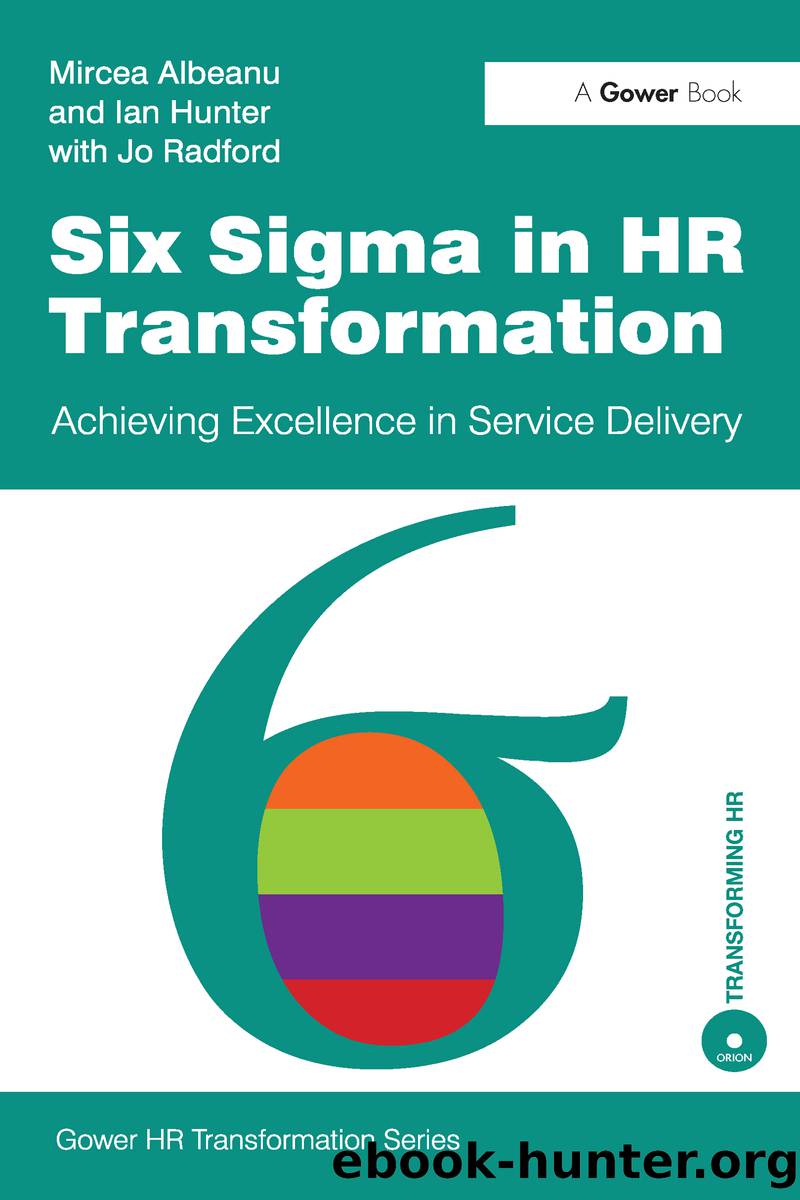Six Sigma in HR Transformation by Albeanu Mircea;Hunter Ian;Albeanu Mr Mircea;Hunter Mr Ian;

Author:Albeanu, Mircea;Hunter, Ian;Albeanu, Mr Mircea;Hunter, Mr Ian;
Language: eng
Format: epub
Publisher: Taylor & Francis Group
Published: 2010-08-15T00:00:00+00:00
The data that needs to be used for analysis might already be available in the corporate management information, HR information systems or customer relationship management systems.
The choice of data collection methods will typically be limited by organisational realities such as which method causes least disruption and which method is most acceptable to those who will be collecting the data so that the maximum reliability of the data is maintained. For example, if the people who are doing a job will also have to measure the effectiveness of their job, they may be tempted to bias measurements in their favour. To instigate this, data should be measured as much as possible through automated means - which is possible with the aid of business applications such as workflow systems and customer relationship management systems, which are commonly used in the service industry. Disturbance within the process caused by measurement usually happens because the measurement tasks themselves affect the output of the overall process.
At the end of the Measure phase, the team will have gathered all the data needed to assess the effectiveness of the current process, and will have done so in a way that minimises the need to gather data which is not relevant or will not be used. Frequently organisations either gather data that is not relevant to the problem they are trying to solve, or gather so much data that little that is effective can be done with it. Running a clear Measurement phase means that real thought will be applied to the data collection, minimising wasteful work but making sure the data needed is in place.
The final stage of the Measure phase is to communicate the result. Communication features at the end of each Six Sigma phase, as an indicator that stakeholders must be kept up to date, affected and interested parties and so on. The Six Sigma approach itself does not define particular tools and methodologies for this communication, and we suggest you craft a communication and engagement plan for your transformation project that runs for the life of the project, focusing on maintaining high stakeholder engagement throughout.
Case study - Part VII (Measure)
M.3 Data collection plan
In order to collect the requisite data, the Six Sigma team used two custom built online (web) applications as follows:
query data collection tool: This tool was built to collect the data regarding customer queries. For every call the following variables are entered into the query tool: â average time to answer (Automatically obtained from phone switch),
â hand off or not (Yes/No - entered by operator),
â call duration (measured by switch from the answer to hang up),
â standardised procedure available (Yes/No - entered by operator),
â knowledge base needed (Yes/No - entered by operator),
â if needed - answer found in knowledge base (Yes/No - entered by operator),
â department,
â query type,
â query complexity (1 to 5 rating of complexity),
â comments.
Download
This site does not store any files on its server. We only index and link to content provided by other sites. Please contact the content providers to delete copyright contents if any and email us, we'll remove relevant links or contents immediately.
| Agile | Lean |
| Quality Control | Six Sigma |
| Total Quality Management |
Hit Refresh by Satya Nadella(8854)
The Compound Effect by Darren Hardy(8508)
Change Your Questions, Change Your Life by Marilee Adams(7371)
Nudge - Improving Decisions about Health, Wealth, and Happiness by Thaler Sunstein(7240)
The Black Swan by Nassim Nicholas Taleb(6762)
Deep Work by Cal Newport(6562)
Daring Greatly by Brene Brown(6222)
Rich Dad Poor Dad by Robert T. Kiyosaki(6174)
Principles: Life and Work by Ray Dalio(5957)
Man-made Catastrophes and Risk Information Concealment by Dmitry Chernov & Didier Sornette(5645)
Playing to Win_ How Strategy Really Works by A.G. Lafley & Roger L. Martin(5492)
Digital Minimalism by Cal Newport;(5389)
Big Magic: Creative Living Beyond Fear by Elizabeth Gilbert(5351)
The Myth of the Strong Leader by Archie Brown(5237)
The Slight Edge by Jeff Olson(5199)
Discipline Equals Freedom by Jocko Willink(5156)
The Motivation Myth by Jeff Haden(5001)
Stone's Rules by Roger Stone(4853)
The Laws of Human Nature by Robert Greene(4770)
